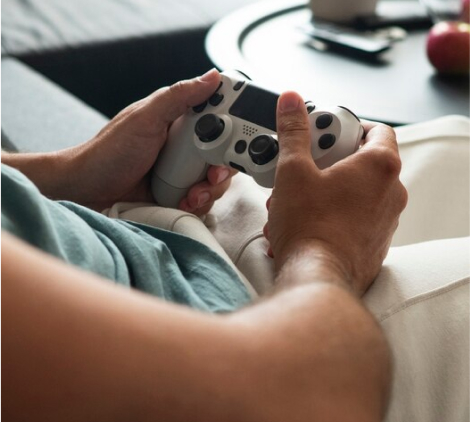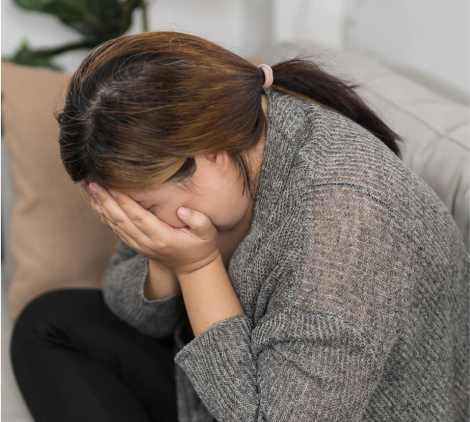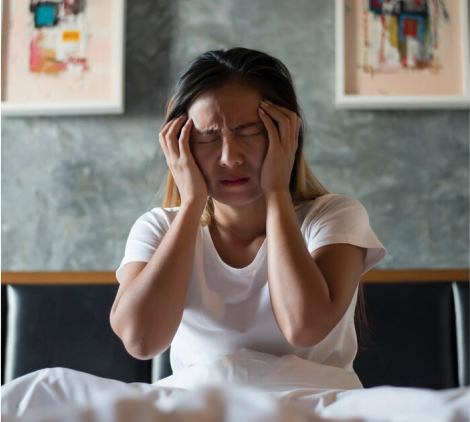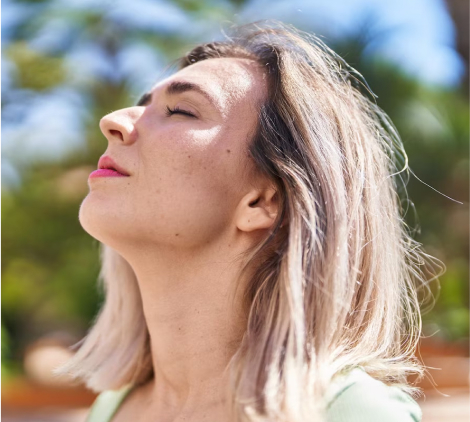By We Level Up FL Treatment Center | Editor Yamilla Francese | Clinically Reviewed By Lauren Barry, LMFT, MCAP, QS, Director of Quality Assurance | Editorial Policy | Research Policy | Last Updated: April 17, 2023
Top 6 Grounding Techniques For Anxiety
People suffering from anxiety understand what anxiety attacks feel like when the physical symptoms of anxiety attacks rush in. Your heart races, and your mouth is while your body may even begin to shake. Some will even break out in a sweat. Panic attacks take over your mind, disregarding reason and facts. What if we could teach you the top 5 grounding techniques for anxiety attacks? You have the power within you to end anxiety attacks and stop them from engulfing you in a spiral of stress and fear. Read below for our greatest five grounding techniques for anxiety attacks that work.
Recollections and thoughts of prior trauma or an uncertain stressful future often trigger anxiety and PTSD. These thoughts become so heightened trigger a fight-or-flight response. The brain senses that you are under attack and reacts to a nonexistent danger.
Lastly, anxiety grounding techniques can be both physical and mental activities that distract you from ongoing moments filled with anxiety and highly weighted stress. The breathing and grounding techniques for anxiety you practice can calm you and help you focus on the present and what’s happening around you. Read below our top 6 best strategies to cope with anxiety and highly stressful situations.
Easy Ways To Cope With Anxiety & How to Ground Yourself from Anxiety?
Substance Abuse and Mental Health Services Administration outlines one approach to using anxiety attack grounding. [2] Although this approach suits medical practitioners to conduct for patients, you can also use it on yourself or with another person. Try to have a list of grounding questions for anxiety based on the following steps.
To follow these grounding methods for anxiety, a person should:
- Place the feet firmly on the ground.
- State the date and time.
- Take slow, deep breaths.
- State what they can observe in their present environment.
- Remind themselves that they are in a safe place right now.
- Observe their immediate surroundings and describe items in the room or environment.
You can use visualization exercises or sensory diffusers to diminish the intensity of your feelings. Some techniques include:
- Visualizing turning down an emotional dial.
- Clenching their fist to hold on to the emotions, then letting them go when they release their fist.
- Visualizing a safe place through guided imagery.
- Distracting themselves.
Achieving distraction from memories of the past may include trying different strategies. Some examples include:
- Focusing on recent or future events, such as a to-do list for the day.
- Reminding oneself of their current safety.
- Touching a chair or wiggling the toes to remind oneself of the current reality.
- Counting or reciting something to return focus to the present.
Use positive coping statements. Changing or disrupting a pattern of anxious thoughts by replacing them with more calming or supportive statements can help to divert a panic attack. Some common helpful coping statements:
- This is not an emergency.
- “I don’t like feeling this way, but I can accept it.”
- I can feel like this and still be okay.
- This has happened before, and I was okay. I’ll be alright this time, too.
- I can be anxious and still deal with this situation.
- I can handle these symptoms or sensations.
Cognitive interventions may help you ground yourself. First, Identify your negative self-talk. Anxious thoughts can increase anxiety symptoms and panic. Identifying negative, alarming self-talk is the first step in changing anxious thinking. [3] Some common disturbing thoughts:
- I’m having a heart attack.
- I must be going crazy.
- I think I’m dying.
- People will think I’m crazy.
- I’m going to pass out.
- Oh no – here it comes.
- I can’t stand this.
- I’ve got to get out of here!
How To Cope With Anxiety? 5 Easy Smart Coping With Anxiety Strategies.
The most powerful grounding techniques for anxiety apply all five senses to bring you back to focus on the present. These five steps to improve your anxiety merely apply real-time thoughts to help refocus when coping with anxiety:
- Five things you can see;
- Four things you can feel;
- Three things you can hear;
- Two things you can smell; and
- One thing you can taste in your immediate environment.
Identifying ways to cope with anxiety can begin by taking hold of objects in the material world to help calm your heart rate. And secondly, re-direct your focus from intense thoughts of high anxiety to other less stressful thoughts and/or activities.
Anxiety Causes & Coping With Anxiety
Fear is an automatic neurophysiological state of alarm characterized by a fight or flight response to a cognitive appraisal of present or imminent danger (real or perceived). Anxiety is linked to fear and manifests as a future-oriented mood state that consists of a complex cognitive, affective, physiological, and behavioral response system associated with preparation for the anticipated events or circumstances perceived as threatening.
Pathological anxiety is triggered when there is an overestimation of the perceived threat or an erroneous danger appraisal of a situation, leading to excessive and inappropriate responses. Anxiety is one of the most common psychiatric disorders, but the true prevalence is not known as many people do not seek help or clinicians fail to make the diagnosis. [1]
Anxiety disorders appear to be caused by an interaction of biopsychosocial factors. Genetic vulnerability interacts with stressful or traumatic situations to produce clinically significant syndromes. The following conditions can cause anxiety:
- Medications.
- Herbal medications.
- Substance abuse.
- Trauma.
- Childhood experiences.
- Panic disorders.
Grounding Techniques for Anxiety Disorders For Severe Cases
Acute anxiety may require treatment with medications. Chronic anxiety treatment consists of psychotherapy, pharmacotherapy, or a combination. Does grounding help anxiety? Yes. Anxiety grounding techniques are effective for some, but contacting a mental health professional is the best option for severe cases.
Mental Grounding Techniques Activities That Work
Grounding techniques meaning in mental health, are relaxing and pleasurable activities that decrease stress and anxiety. It can also be beneficial for ADHD grounding techniques. When anxious, you are out of touch with the present moment. Anxious thoughts are past and future-focused. These techniques with grounding objects for anxiety help you reconnect to the present and feel calmer and safer here and now. How to ground yourself? Most of the methods presented below focus on some aspects of your five senses: touch, taste, sight, sound, and smell. Senses are in the present. By heightening your awareness of your surroundings and body, you can also heighten your awareness of the moment you live within.
- Press your feet firmly to the ground to remind yourself where you are.
- Carry a polished stone or soft piece of cloth to the touch.
- Carry a soothing picture and look at it when you feel anxious.
- Eat or drink a favorite food. Enjoy it slowly. Please don’t do anything else while consuming it except focus on enjoying and savoring it.
- Notice where you are, including the people, sites, and sounds as if you were watching a T.V. show.
- Exercise, Stretch. Massage your muscles to relax them and reduce tension.
- Concentrate on your breathing. Take a deep, cleansing breath in through your nose and count. Exhale.
- Slowly through your mouth for twice as long. Continue for five minutes.
- Slowly and deliberately cross your legs and arms. Feel the sensations of you controlling your body.
- Call a friend and talk to them about something you have recently done or want to do together.
- Take a warm, relaxing bubble bath or shower, and pay attention to the water touching your body.
- Light a candle of your favorite scent or visit a place with pleasant smells (bakery, coffee shop, etc.)
- Verbalize the following “It was just a thought or memory.” “It’s over now.” “I am safe now.” Permit yourself not to think about it right now.
- Realize that no matter how small you feel, you are an adult. Envision yourself to be safe, strong, and capable.
- Find your pulse on your wrist or neck and count the beats per minute.
- Go outside. If it’s warm, feel the sun shining down on your face. If it’s cold, feel the breeze tickle against your skin. How does it make your body feel? Sit against a tree. Feel the bark pressing against your back. Smell the outside aromas like the grass and leaves. Run your fingers through the grass.
- Hold something that you find comforting, a stuffed animal or a blanket. Notice how it feels in your hands.
- Go outside and watch the clouds or go for a walk.
- Get active. Do the dishes, clean your room, or redecorate. Organize your dresser or closet.
- Pet or play with an animal. If you don’t have one, visit a friend, pet store, or shelter.
- Listen to familiar, comforting music and sing along to it. Dance to it.
- Write in your journal. Pay attention to yourself holding the pencil. Write about what you remember and visualize the memory traveling out of you into the pencil and onto the paper. Tear the paper up.
- Watch a favorite fun TV program, DVD, or your favorite website. Play a video game.
- Color in a coloring book or doodle on a notepad. Focus on the feeling of your writing utensil moving across the paper.
- Look up pictures or paintings online that you find beautiful. Save them as your background image or hang them in your room.
- Check out an audiobook from the library and listen to it.
- Go somewhere you’ve never been (restaurant, museum, etc.).
- Play white noise (simplynoise.com) or running water. Set up a mini water fountain or run a fan to provide soothing background noise. Go to a park or the Arboretum and listen to the sounds of nature.

Skip To:
Learn More:
- Top 5 Activities That Can Reduce Anxiety
- SSRI for Anxiety
- Depression and Anxiety Quotes
- Common Anxiety Medications
- Non-Addictive Anti-Anxiety Medications
- Anxiety Disorder Treatment
- Grounding Techniques for Dissociation
- Grounding Techniques for Panic Attacks
- What is Cognitive Behavioral Therapy? CBT Techniques, Uses & Mental Health Treatment
- Who Is Inpatient Mental Health Treatment For? How Long Does Mental Health Treatment Last? Inpatient Mental Health Treatment Options
Anxiety Fact Sheet
Anxiety Overview
Your brain and behavior are both impacted by the condition of addiction. Substance addiction makes it unable to resist the impulse to use the drug, regardless of how harmful it may be. The sooner you receive treatment for drug addiction, the better your chances are of avoiding some of the disease’s more serious side effects.
Anxiety Symptoms
Behavioral: hypervigilance, irritability, or restlessness.
Cognitive: lack of concentration, racing thoughts, or unwanted thoughts.
Whole body: fatigue or sweating
Also common: anxiety, excessive worry, angor animi, fear, insomnia, nausea, palpitations, or trembling
Anxiety Treatment
- Support group: A place where those pursuing the same disease or objective, such as weight loss or depression, can receive counseling and exchange experiences.
- Cognitive behavioral therapy: A conversation treatment that aimed to change the negative attitudes, actions, and feelings connected to psychiatric discomfort.
- Counseling psychology: A subfield of psychology that handles issues with the self that are connected to work, school, family, and social life.
- Anger management: To reduce destructive emotional outbursts, practice mindfulness, coping skills, and trigger avoidance.
- Psychoeducation: Mental health education that also helps individuals feel supported, validated, and empowered
- Family therapy: psychological counseling that improves family communication and conflict resolution.
Grounding Techniques For Anxiety PDF
Anxiety Statistics
It’s critical to understand the distinction between anxiety and depression. Anxiety, in its most basic form, is an excessive feeling of worry, whereas depression, in its most basic form, is an extreme feeling of worthlessness and hopelessness. It is conceivable for someone to experience depression and anxiety simultaneously.
6.8 million
GAD affects 6.8 million adults, or 3.1% of the U.S. population, yet only 43.2% receive treatment.
Source: National Institute on Mental Health
10.3 %
Nineteen million adults experience specific phobias, making it America’s most common anxiety disorder.
Source: ADAA, 2020
17.3 million
Major depressive disorder affects approximately 17.3 million American adults, or about 7.1% of the U.S. population aged 18 and older.
Source: National Institute of Mental Health
Get Help. Get Better. Get Your Life Back.
Searching for Accredited Dual Diagnosis Mental Health Centers Near You?
Even if therapy failed previously, or are in the middle of a difficult crisis, we stand ready to support you. Our trusted behavioral health specialists will not give up on you. When you feel ready or just want someone to speak to about counseling alternatives to change your life call us. Even if we cannot assist you, we will lead you to wherever you can get support. There is no obligation. Call our hotline today.
FREE 24/7 Dual Diagnosis Mental Health Services HotlineGrounding Techniques for Anxiety Attack Five Senses
What are grounding techniques for anxiety? How can they help cope with anxiety? Anxiety grounding techniques 5 senses or 5, 4, 3, 2, 1 is a mindfulness practice used to cope with, relieve, and manage stress. These “grounding techniques anxiety” can help increase awareness and decrease invasive thoughts during heightened anxiety, worry, or panic attacks.
The grounding for anxiety 5, 4, 3, 2, 1 technique works by following these simple steps:
Techniques for grounding oneself are within your reach. Start by bringing your attention to your breathing and taking deep, slow breaths.
- Notice 5 things you can see in your surrounding area. These may include the blue sky, a cloud, a plant, a chair, a pen, a cup, the table, a person, or anything in your surroundings while grounding oneself.
- Notice 4 things you can touch near you. This could be the floor, the wall, your hair, your clothes, the sweat on your palms, or the coolness of a glass of water.
- Notice 3 sounds you can hear. This could be birds chirping in the background, construction, a car driving nearby, or music far away.
- Notice 2 scents you can smell. This could include the smell of flowers nearby, your tea, fresh-cut grass, your clothes, or simply the scent of the space you are in. Can’t find anything to smell? Consider taking a short walk outside to smell nature, to the kitchen for food smells, or the bathroom for soap.
- Notice 1 flavor you can taste. This can be tough, but it can be as simple as the taste of your tongue! Can you taste the coffee from the morning, your lunch, or a mint that you had?
The Anxiety 5, 4, 3, 2, 1 exercise can also be used as an imaging technique for grounding oneself. For instance, if you fear flying and are on an airplane preparing for takeoff, acknowledging the sights and sounds around you could cause you to feel more nervous. You may want to imagine the destination ahead instead! Imaging the feeling of your toes in the sand, the smell of the ocean breeze, or the taste of your favorite comfort food could be more helpful.
The “Anxiety 5, 4, 3, 2, 1 technique” is grounded in mindfulness, which helps calm the nervous system. By shifting your attention from focusing on the causes of anxiety to being curious about your present sensations, the technique encourages you to change your brain’s response to stress in two important ways. It can also be used for dissociation grounding techniques, grounding techniques for PTSD or grounding exercises for PTSD, and grounding techniques for ADHD. Find out more about 5 grounding techniques for panic attacks here.
World-class, Accredited, 5-Star Reviewed, Effective Mental Health Dual Diagnosis Programs. Complete Integrated Inpatient Rehab with Free Post Discharge Therapy Planning.
CALL (855) 940-6125End the Emotional Pain Rollercoaster. Gain Stability & Happiness Through Recovery Treatment. Start Mental Health Counseling Today. Get Free No-obligation Guidance by Behaviroal Health Specialists Who Understand Mental Health Recovery.
Five Senses Anxiety Attacks Grounding Techniques
Ground techniques for anxiety often use the five senses—sound, touch, smell, taste, and sight—to immediately connect you with the here and now. For example, singing a song, rubbing lotion on your hands, or sucking on sour candy are all grounding techniques that produce sensations that are difficult to ignore or distract you from what’s going on in your mind.
This helps you directly and instantaneously connect with the present moment. At the same time, panic attack grounding techniques reduce the likelihood that you will slip into a flashback or dissociation.
How you are grounding mental health is highly personal. What works for one person may trigger anxiety or flashbacks in another. You may need trial and error to determine what “grounding skills for anxiety” work best. Pay attention to the coping mechanisms you’ve already developed to help you get through flashbacks and anxiety, and see if you can build on them and use them as grounding techniques.

Adults could all benefit from learning a few more ways to calm down their bodies and minds when negative emotions take over. These skills are often called self-regulation or “grounding yourself anxiety.” The brain’s process allows for control over behaviors and emotions in response to particular situations. It’s holding the skills to calm oneself down when feelings start to rise, adjust expectations, and handle frustration without needing an outburst, including using the body to hurt others. When people can listen to others, keep their bodies to themselves, and pause before reacting, they practice self-control for “grounding oneself.”
Most often, self-regulation is a foundation skill learned in early childhood. If we teach children strategies to stay calm in upsetting or stressful situations, they start to develop habits they can continue to use throughout their lives. Fortunately, we can learn new skills and techniques at any age with an open mind and desire for change. These grounding techniques for depression and anxiety revolve around using the five senses of touch, taste, smell, hearing, and seeing to ground oneself. Below are two grounding exercises that ask kids and adults to utilize their five senses to stop negative emotions from overwhelming them.
To connect with the here and now, do something (or several things) that will bring all your attention to the present moment. Keep your eyes open while you are “grounding for anxiety attacks” so you know everything around you.
Try anxiety attack grounding techniques if you’re slipping into a flashback or a dissociative state.
1. Smell
- Get some essential oils that remind you of good times (freshly cut grass, rain, clean laundry, or sugar cookies, for example) and smell one.
- Light a scented candle or melt scented wax.
- Sniff strong peppermint, which also benefits having a soothing effect.3
4. Sound
- Call a loved one.
- Put on some natural sounds, such as birds chirping or waves crashing.
- Read out loud, whether it’s a favorite children’s book, a blog post, or a novel.
- Talk out loud about what you see and hear or what you’re thinking or doing.4
- Turn up the radio or blast your favorite song.
2. Sight
- Complete a crossword puzzle, sudoku, word search, or another puzzle.
- Count all the pieces of furniture around you.
- Play a distracting game on your tablet, computer, or smartphone.
- Put on your favorite movie or TV show.
- Read a book or magazine.
- Take a mental inventory of everything around you, such as the colors and patterns you see, the sounds you hear, and the scents you smell. Saying this out loud is helpful too.
5. Taste
- Bite into a lemon or lime.
- Let a piece of chocolate melt in your mouth, noticing how it tastes and feels as you roll it around with your tongue.
- Suck on a mint or chew peppermint or cinnamon gum.
- Take a bite of pepper or some hot salsa.
3. Touch
- Cuddle and pet your dog or cat if you have one.
- Drink a hot or cold beverage.
- Grab an article of clothing, a blanket, or a towel and knead it in your hands or hold it to your cheek. Concentrate on what it feels like.
- Hold an ice cube and let it melt in your hand.
- Massage your temples.
- Pop some bubble wrap.
- Put your hands under running water.
- Rub your hand lightly over the carpet or furniture, noting the texture.
- Take a hot or cool shower.
Other
- Dance.
- Go for a walk or run.
- Send a letter or card to someone you care about.
- Sit in another room or area for a change of scenery.
- Stretch your arms, neck, and legs.
- Take ten slow, deep breaths.
- Write in a journal about how you’re feeling, or keep a list of prompts handy that you can use to decide what to write about.

End the Emotional Pain. Get Your Life Back.
Feeling Depressed, Anxious or Struggling with Mental Health Illness? Get Safe Comfortable Mental Health Dual Diagnosis High-Quality Therapy From Counselors That Care. Begin Your Recovery Now.
Hotline (855) 940-6125How Do Grounding Techniques Help Reduce Anxiety?
Let’s say you’ve had an unpleasant experience with public speaking. Perhaps you were humiliated by your teacher in front of the whole class. Or maybe you forgot your lines during a school play and left the stage feeling ashamed.
Now you work at a sales company and must deliver product presentations to potential clients. The stakes are high, and you don’t want them to leave disappointed or confused.
However, the minute you walk into the room, your palms get sweaty, you begin to feel slightly dizzy, and everything seems ‘unreal.’ The more you focus on your anxious thoughts, the more disconnected you feel from everything that’s going on around you.
It’s tough to deliver a fluent presentation and create a connection with your audience when anxiety keeps you trapped in a never-ending circle of catastrophic scenarios.
And that’s why you need to re-establish a connection with your surroundings, leave worries in the back of your mind and ground yourself in the ‘here and now.’

Using your five senses, you can anchor yourself in the present moment by focusing on sensations that are hard to ignore. For instance, the touch of your pen slowly gliding on a piece of paper, the sound of people talking on their phones or typing on their computers, and the smell of fresh coffee.
The more connected you are with your surroundings, the less likely you will lose yourself in anxious thoughts and have a nervous breakdown. Furthermore, grounding exercises for panic attacks can also reduce the likelihood of flashbacks and dissociation.
Before trying these strategies, remember that grounding techniques for anxiety attacks are a personal practice. In other words, what works for some might only work for some. Also, that’s why it’s crucial to experiment with several grounding tools for dissociation, ADHD grounding techniques, and anxiety grounding tools before you find the ones that work best for you.
First-class Facilities & Amenities
World-class High-Quality Mental Health Services & Behavioral Health Substance Abuse Treatment
Rehab Centers TourRenowned Mental Health Centers. Serene Private Facilities. Inpatient Rehab Programs Vary.
Mental Health Helpline (855) 940-6125Proven recovery success experience, backed by a Team w/ History of:
15+
Years of Unified Experience
100s
5-Star Reviews Across Our Centers
10K
Recovery Successes
- Comprehensive Dual-Diagnosis Treatment
- Complimentary Family & Alumni Programs
- Coaching, Recovery & Development Events
- Comfortable Onsite Medical Detox Center
Grounding Techniques Can Be Done Anywhere
The nice thing about anxiety grounding methods is that many can be done in any environment. Grounding oneself could mean an individual might be alone or in public. Still, once you feel that flashback or dissociation coming on, you can use grounding activities for anxiety to move your focus back to the present. Working on grounding activities for adults takes dedication and becomes easier over time. Try something else if these particular grounding techniques don’t work for you. For example, some people find that a rubber band on their wrist helps snap them back to the moment. The ultimate goal is to live now and focus on the present when the past starts coming up.
According to the Anxiety and Depression Association of America, anxiety is a common disorder that affects about 18 percent [1] of adults in the United States. Immersing yourself in your senses may help reduce symptoms of stress and worry. You can follow simple exercises that activate your senses — sight, touch, hearing, smell, and taste. For example, listening to birds chirping or smelling fresh-cut grass could help you focus less on your anxious thoughts and more on the present moment.
If you have difficulty managing your anxiety, contact a mental health expert. They can provide you with additional tools to manage your symptoms and discover the root cause of the anxiety.

CBT Grounding Techniques
Grounding during panic attacks can be a powerful tool to help you cope with distressing thoughts. If you’re having trouble using grounding for mental health, a therapist may be able to assist. Getting help from a therapist is also essential to address the root cause of your distress.
Using cognitive behavioral therapy, your therapist will help you slowly re-create panic attack symptoms safely and repeatedly. Once the physical feelings of panic no longer feel threatening, the panic attacks resolve. Successful treatment and “grounding techniques CBT” can also help you overcome fears of situations you’ve avoided because of panic attacks.
It may require some time and effort to see therapeutic outcomes. Within a few weeks, you could see a decrease in panic attack symptoms; usually, however, this happens over several months. You can arrange periodic maintenance appointments to keep your panic episodes under control or treat recurrences.
Experience Transformative Recovery at the We Level Up Treatment Center.
See our authentic success stories. Get inspired. Get the help you deserve.



Start a New Life
Begin with a free call to a behavioral health treatment advisor. Learn more about our dual-diagnosis programs. The We Level Up treatment center network delivers recovery programs that vary by each treatment facility. Call to learn more.
- Personalized Care
- Caring Accountable Staff
- Comfortable Amenities
- Licensed & Accredited
- Renowned w/ 5-Star Reviews
We’ll Call You
Grounding Techniques For Social Anxiety
Everyone gets nervous in certain social situations. Since everyday events can be extra challenging if you have a social anxiety disorder (social phobia). You might feel much more self-conscious and scared than others in social interactions and suffer from low self-esteem. Try these good grounding techniques to help you feel better and get through the day. Also, people sometimes need professional help to deal with social anxiety.
- Control Your Breathing – Certain techniques can help you slow your breathing and manage other anxiety symptoms. Try these steps.
- Shut your eyes and pay attention to how you usually breathe for several breaths.
- Then, slowly count 1-2-3-4 as you inhale through your nose.
- Exhale for the same four-second count.
- As you inhale and exhale, be mindful of the feelings of fullness and emptiness in your lungs.
As you continue practicing equal breathing, your second count might vary. Be sure to keep your inhale and exhale the same.
- Try Exercise or Progressive Muscle Relaxation – Research shows that physical activities like jogging can help lower your anxiety. Progressive muscle relaxation can help, too. Yoga can also help you calm down.
- Prepare – Plan for social situations that make you nervous can help you feel more confident. You might feel the urge to avoid some situations because they make you anxious. Instead, try to prepare for what’s to come.
- Start Small – Don’t jump into big social situations. Schedule restaurant meals with friends or family so you can get used to eating in public. Try going out of your way to make eye contact with people on the street or at the grocery store and say hello. Be patient with yourself. It takes time and practice to tackle social anxiety.
- Take the Focus Off Yourself – Try shifting your attention to what’s happening around you instead of what’s inside your head. You can do this by listening to the conversation or reminding yourself that others probably can’t tell how anxious you are just by looking at you.
- Talk Back to Negative Thoughts – These thoughts might be about people or situations and may even be automatic. Most of the time, they’re wrong.
- Use Your Senses – Sight, sound, smell, touch, and taste — your senses can help calm you down when you’re anxious.
Anxiety Treatment
As a mental treatment center in Florida, we understand how difficult it can be to manage anxiety symptoms. We’re sharing some of the best grounding techniques for panic attacks. While you can find many ways to “ground yourself anxiety,” you can also create your own. Everyone is different and copes with stress and anxiety differently. For example, if taking a short walk helps you calm down, do that as your anxiety grounding method.
Do what works for you. However, while these grounding techniques for adults can help you calm down during a panic attack, they are not long-term solutions. If you believe you have a panic disorder, seek pain attack treatment for a formal diagnosis and therapy.
If you have a mental disorder or believe a loved one is showing signs of mental illness, we can help. We Level Up FL offers different mental health treatments for all conditions. We’re here for you, whether you have depression, anxiety, or bipolar disorder. Call our inpatient mental health rehab today to find out how to get started.
The We Level Up FL primary mental health center stands ready to help. We Level Up FL can inspire a support system through our mental health treatments to make you feel valuable. You can trust the treatment backed by leading recovery specialists practicing evidence-based therapy. We Level Up FL Treatment Center offers therapy under one roof. Get comprehensive therapy for mind, body & spirit.
Call us now for a free mental health assessment! In addition, for the substance abuse or dual diagnosis approach, our inpatient treatment, inpatient medical detox, and primary residential addiction treatment may be available at our affiliated facility. For more treatment resources and grounding technique for anxiety, call us about your symptoms, and we can help you determine the cause and develop a treatment plan.
Powerful Coping Skills for Anxiety. Top Mental Health Tips & Anxiety Tips Advice from a Therapist Video.
4 Mental Health Tips & Advice From A Therapist To Remove Your Everyday Anxiety
“Anxiety, when gone untreated, can increase over time.
So here are four tips to calm your everyday anxiety.
Take a breath.
Do something that you enjoy.
Remove yourself from the situation and go for a walk.
Doing these four things gives you a better chance of calming your everyday anxiety.”
Search Grounding Techniques for Anxiety & Other Resources
Sources:
[1] Chand SP, Marwaha R. Anxiety. [Updated 2022 May 8]. In: StatPearls [Internet]. Treasure Island (FL): StatPearls Publishing; 2022 Jan-. Available from: https://www.ncbi.nlm.nih.gov/books/NBK470361/
[2] Grounding Techniques – Substance Abuse and Mental Health Service Administration SAMHSA
[3] VA Healthcare Panic Attacks – https://www.mirecc.va.gov/cih-visn2/documents/patient_education_handouts/panic_attacks_version_3.pdf
[4] Chand SP, Marwaha R. Anxiety. [Updated 2022 May 8]. In: StatPearls [Internet]. Treasure Island (FL): StatPearls Publishing; 2022 Jan-. Available from: https://www.ncbi.nlm.nih.gov/books/NBK470361/
[5] Kim YK. Panic Disorder: Current Research and Management Approaches. Psychiatry Investig. 2019 Jan;16(1):1-3. DOI: 10.30773/pi.2019.01.08. Epub 2019 Jan 25. PMID: 30696237; PMCID: PMC6354045.
[6] Munir S, Takov V. Generalized Anxiety Disorder. [Updated 2022 Jan 9]. In: StatPearls [Internet]. Treasure Island (FL): StatPearls Publishing; 2022 Jan-. Available from: https://www.ncbi.nlm.nih.gov/books/NBK441870/
Najavits, L. (2002). Seeking safety: A treatment manual for PTSD and substance abuse. Guilford Publications.
Adams KS, et al. (2020). Emotion dysregulation and anxiety in students: Mindfulness strategies for school counselors.
eric.ed.gov/?id=EJ1278249
Gee NR, et al. (2021). Dogs supporting human health and well-being: A biopsychosocial approach.
ncbi.nlm.nih.gov/pmc/articles/PMC8042315/
Grounding techniques. (n.d.).
jmu.edu/counselingctr/files/Grounding%20Techniques.pdf





